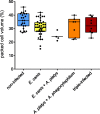Seroprevalence and current infections of canine vector-borne diseases in Nicaragua
- PMID: 30419951
- PMCID: PMC6233566
- DOI: 10.1186/s13071-018-3173-1
Seroprevalence and current infections of canine vector-borne diseases in Nicaragua
Abstract
Background: Vector-borne diseases constitute a major problem for veterinary and public health, especially in tropical regions like Central America. Domestic dogs may be infected with several vector-borne pathogens of zoonotic relevance, which may also severely compromise canine health.
Methods: To assess the prevalence of canine vector-borne diseases in Nicaragua, 329 dogs from seven cities, which were presented to the veterinarian for various reasons, were included in this study. Dogs were examined clinically and diagnostic blood samples were taken for analysis of packed cell volume (PCV) and presence of microfilariae as well as antigen of Dirofilaria immitis and antibodies to Ehrlichia spp., Anaplasma spp. and Borrelia burgdorferi (sensu lato) by use of a commercially available rapid ELISA. To detect current infections, specific PCRs for the detection of E. canis, A. platys and A. phagocytophilum were carried out on blood samples of the respective seropositive dogs. Microfilaremic blood samples, as well as D. immitis antigen positive samples were further subjected to PCR and subsequent sequencing for filarial species identification.
Results: Antibodies against Ehrlichia spp. were present in 62.9% of dogs, while Anaplasma spp. seroprevalence was 28.6%. Antibodies against species of both genera were detected in 24.9% of dogs. Borrelia burgdorferi (s.l.) antibodies were not detected. Dirofilaria immitis antigen was present in six animals (1.8%), two of which also showed D. immitis microfilariae in buffy coat. In addition to D. immitis, Acanthocheilonema reconditum was identified by PCR and sequencing in two of four additional microfilaremic blood samples, which were tested negative for D. immitis antigen. Current E. canis infections as defined by DNA detection were present in 58.5% of Ehrlichia-seropositive dogs, while 5.3% of Anaplasma-seropositive dogs were PCR-positive for A. platys, 2.2% for A. phagocytophilum and 16.0% for both Anaplasma species. Current E. canis infection had a statistically significant negative impact on PCV, whereas no relationship between infection status and clinical signs of disease could be observed.
Conclusions: These results indicate that canine vector-borne diseases are widespread in Nicaragua and that dogs may constitute a reservoir for human infection with E. canis, A. phagocytophilum and D. immitis. Thus, the use of repellents or acaricides to protect dogs from vector-borne diseases is strongly recommended.
Keywords: Anaplasma spp.; Central America; Ehrlichia spp.; Rickettsia spp.; Tick-borne diseases; Ticks; Vector-borne diseases; Zoonoses.
Conflict of interest statement
Ethics approval and consent to participate
Not applicable.
Consent for publication
Not applicable.
Competing interests
The authors declare that they have no competing interests.
Publisher’s Note
Springer Nature remains neutral with regard to jurisdictional claims in published maps and institutional affiliations.
Figures


Similar articles
-
Canine infection with Dirofilaria immitis, Borrelia burgdorferi, Anaplasma spp., and Ehrlichia spp. in the United States, 2013-2019.Parasit Vectors. 2021 Jan 6;14(1):10. doi: 10.1186/s13071-020-04514-3. Parasit Vectors. 2021. PMID: 33407758 Free PMC article.
-
Serological detection of antibodies to Anaplasma spp., Borrelia burgdorferi sensu lato and Ehrlichia canis and of Dirofilaria immitis antigen in dogs from Costa Rica.Vet Parasitol. 2017 Mar 15;236:97-107. doi: 10.1016/j.vetpar.2017.02.009. Epub 2017 Feb 14. Vet Parasitol. 2017. PMID: 28288773
-
Countrywide serological evaluation of canine prevalence for Anaplasma spp., Borrelia burgdorferi (sensu lato), Dirofilaria immitis and Ehrlichia canis in Mexico.Parasit Vectors. 2016 Jul 29;9(1):421. doi: 10.1186/s13071-016-1686-z. Parasit Vectors. 2016. PMID: 27474020 Free PMC article.
-
Co-infections of rickettsiales in clinically healthy, Leishmania infantum seropositive and seronegative dogs: a systematic literature review and new findings from Southern Italy.Parasitol Res. 2025 Jan 29;124(2):14. doi: 10.1007/s00436-025-08458-4. Parasitol Res. 2025. PMID: 39878800 Free PMC article.
-
[Ehrlichiosis and human anaplasmosis].Enferm Infecc Microbiol Clin. 2005 Jun-Jul;23(6):375-80. doi: 10.1157/13076178. Enferm Infecc Microbiol Clin. 2005. PMID: 15970171 Review. Spanish.
Cited by
-
Serological Survey of Canine Vector-Borne Infections in North-Center Spain.Front Vet Sci. 2021 Dec 6;8:784331. doi: 10.3389/fvets.2021.784331. eCollection 2021. Front Vet Sci. 2021. PMID: 34938795 Free PMC article.
-
Molecular detection and characterization of Anaplasma platys and Ehrlichia canis in dogs from the Caribbean.Ticks Tick Borne Dis. 2021 Jul;12(4):101727. doi: 10.1016/j.ttbdis.2021.101727. Epub 2021 Apr 9. Ticks Tick Borne Dis. 2021. PMID: 33865177 Free PMC article.
-
Mapping the canine vector-borne disease risk in a Mediterranean area.Parasit Vectors. 2020 Jun 3;13(1):282. doi: 10.1186/s13071-020-04153-8. Parasit Vectors. 2020. PMID: 32493470 Free PMC article.
-
Epidemiological and Clinicopathological Features of Anaplasma phagocytophilum Infection in Dogs: A Systematic Review.Front Vet Sci. 2021 Jun 23;8:686644. doi: 10.3389/fvets.2021.686644. eCollection 2021. Front Vet Sci. 2021. PMID: 34250067 Free PMC article. Review.
-
The Impact of Deforestation, Urbanization, and Changing Land Use Patterns on the Ecology of Mosquito and Tick-Borne Diseases in Central America.Insects. 2021 Dec 23;13(1):20. doi: 10.3390/insects13010020. Insects. 2021. PMID: 35055864 Free PMC article. Review.
References
MeSH terms
Substances
LinkOut - more resources
Full Text Sources
Miscellaneous

